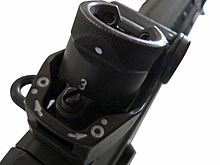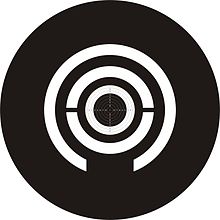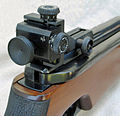- Diopter sight
-
The diopter is an aperture sight component used to assist the aiming of a guns/devices, usually those intended to launch projectiles, such as firearms, airguns, and crossbows. It is found in particular as a rear sight element on rifles.
To obtain a usable sighting line the diopter has to have a complementing front sight element.
Diopter and globe sighting lines are commonly used in ISSF match rifle shooting events.
Contents
Diopter rear sight
 Rear, rotating diopter drum sight of a SIG SG 550 service rifle. The viewing aperture above the "3" (denoting the 300 m setting) can be seen.
Rear, rotating diopter drum sight of a SIG SG 550 service rifle. The viewing aperture above the "3" (denoting the 300 m setting) can be seen.
The diopter is in principle a height and sideways (elevation and windage) adjustable occluder with a small hole (aperture), and is placed close in front of the shooter's aiming eye. Through this small hole the shooter can view the front sight component(s) and the intended target. The typical occluder used in target shooting diopters is a disc of about 2.5 cm (1 in) in diameter with a small hole in the middle.
The small diopter viewing opening ensures the shooter's eye is very precisely and consistently centered behind the diopter sight. The diopter sight is easy to use and usually allows for very accurate aiming, because a relative long sighting line can be used. A long sighting line helps to reduce eventual angle errors and will, in case the sight has an incremental adjustment mechanism, adjust in smaller increments when compared to a further identical shorter sighting line.
High end target shooting diopters normally accept accessories like adjustable diopter aperture and optical filter systems for the aiming eye and semi-transparent occluders for the non-aiming eye to ensure optimal sighting conditions for match shooters. Adding more simple accessories like rubber eye shields for the aiming eye to reduce/eliminate image quality impairing stray light is also often possible.
Typical modern target shooting diopters offer windage and elevation corrections in 2 mm (0.079 in) to 4 mm (0.157 in) increments at 100 m (109.4 yd). Some ISSF(Olympic) shooting events require this precision level for sighting lines, since the score of the top competitors last 10 shots is expressed in 0.1s of scoring ring points.
Complementing front sight element
The complementing front sight element may be a simple (hooded) bead or post for service arms, but is for target shooting more often a globe type sight, which consists of a hollow cylinder with a threaded cap, which allows interchangeable differently shaped front sight elements to be used. Most common are posts of varying widths and heights or rings or holes of varying diameter — these can be chosen by the shooter for the best fit to the target being used. Tinted transparent plastic insert elements may also be used, with a hole in the middle; these work the same way as an opaque ring, but provide a less obstructed view of the target. High end target front sight tunnels normally also accept accessories like adjustable aperture and optical systems to ensure optimal sighting conditions for match shooters. Some high end target sight line manufacturers also offer front sights with integrated aperture mechanisms.
Diopter and globe sighting line principle
The use of round rear and front sighting elements for aiming at round targets, like used in ISSF match shooting, takes advantage of the natural ability of the eye and brain to easily align concentric circles (circles all having a common centre).
For optimal aiming and comfort the shooter should focus the aiming eye on the front sighting element. To avoid eye fatigue and improve balance the non-aiming eye should be kept open. The non-aiming eye can be blocked from seeing distractions by mounting a semi-transparent occluder to the diopter.
Even for the maximum precision, there should still be a significant area of white visible around the bullseye and between the front and rear sight ring (if a front ring is being used). Since the best key to determining center is the amount of light passing through the apertures, a narrow, dim ring of light can actually be more difficult to work with than a larger, brighter ring.
The precise sizes of the employed components are quite subjective, and depend on both shooter preference and ambient lighting, which is why target rifles come with easily replaceable front sight inserts, and adjustable aperture mechanisms.
Gallery
-
An adjustable diopter aperture and optical filter system as used by Olympic 10 metre air rifle contestant Hattie Johnson.
-
Diopter rear sight on a Feinwerkbau 300S 10 metre air rifle.
Categories:- Firearm components
- Firearm sights
-
Wikimedia Foundation. 2010.





